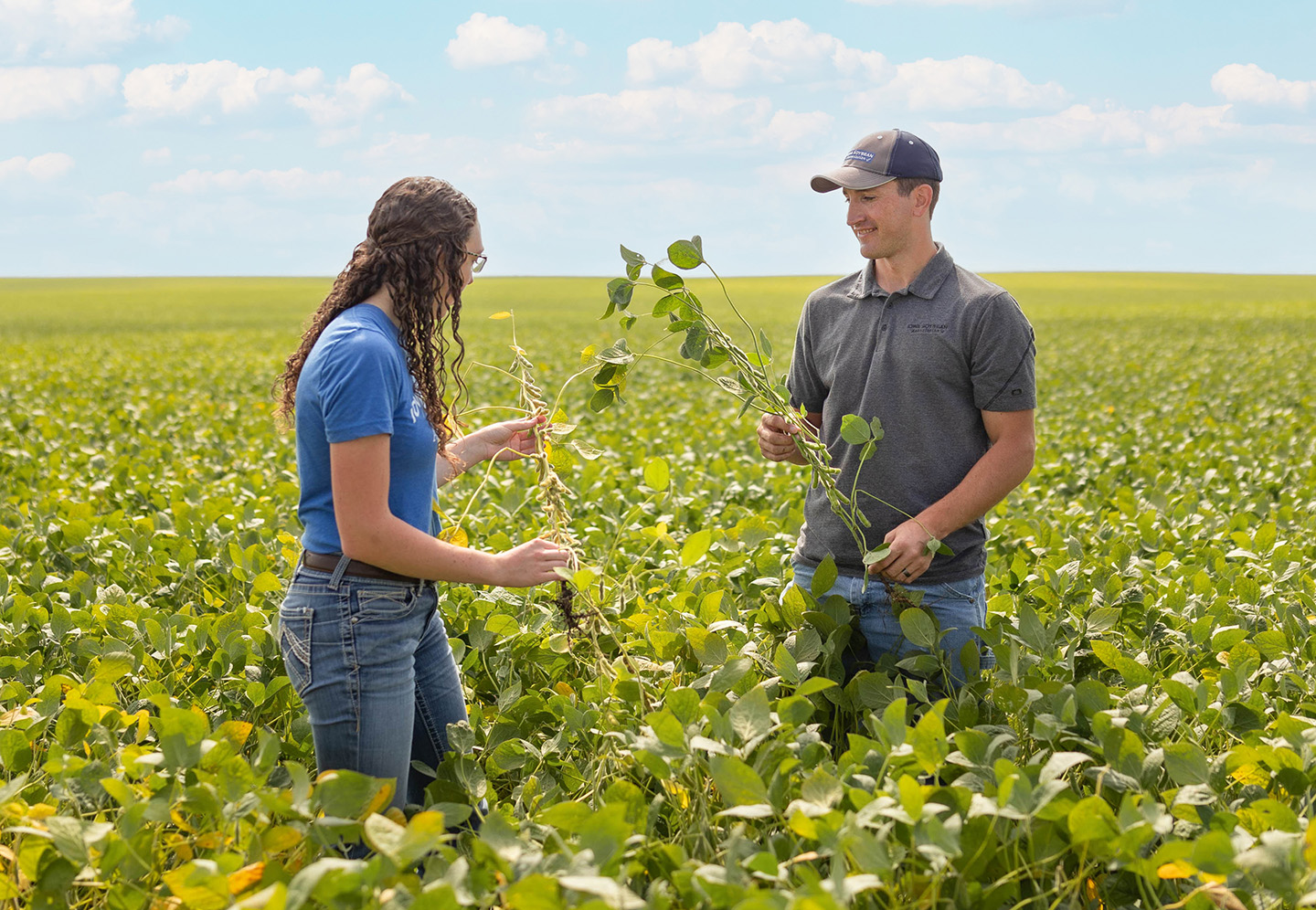
Conservation agronomists Rosie Roberts and Ryan Johnson joined the rest of the Iowa Soybean Association conservation agronomist team to present a webinar introducing keys to improved soil health, water quality and profitability. (Photo: Iowa Soybean Association).
ISA conservation agronomy team is here to help
September 29, 2022 | Kriss Nelson
Cover crops, saturated buffers, bioreactors, no-till and strip-till, are conservation practices that could bring many benefits to the farm.
During the last of the Innovation to Go webinar series, the Iowa Soybean Association’s (ISA) team of conservation agronomists Evan Brehm, Ryan Johnson, Ben Porepp, Rosie Roberts and Joe Wuebker shared how they are available to Iowa farmers for advice on how to implement those conservation practices and to help navigate through cost-sharing opportunities.
Economics and benefits of cover crops
Brehm says Iowa has exceeded two million cover crop acres, and it appears that number will continue to rise.
“We can tell we are increasing our acres as far as cover crops go, and that says something about people seeing the benefits of cover crops,” he says.
If a producer is considering implementing cover crops into their farming operation, Brehm advises setting goals to find out what they want to achieve.
“Do you want to reduce nitrogen? Graze livestock? Or conserving the land to pass on to the next generation,” he says. “I believe farmers see the opportunity for family or a close friend to take over the land, so they want to implement conservation on their acres because they care and want to help their soils.”
The economics and benefits associated with cover crops include:
“There are a lot of herbicide resistance weeds in Iowa,” says Brehm. “Cover crops make herbicides more effective by mitigating those weeds from emerging to a low threshold.”
“Cover crops help reduce wind and water erosion of the soil,” he says. “They keep fertilizer in the field.”
“They help hold nitrogen in the field and draw up phosphorus and calcium that otherwise may not be available to plants,” he says.
Diversity of cover crop species, including grasses, legumes and brassicas, Brehm says can work together to bring various benefits.
“Grasses scavenge nitrogen, the legumes fix nitrogen, brassicas bust compaction and draw up phosphorus,” he says.
Edge-of-field practices
ISA’s conservation agronomists can also assist with the implementation of edge-of-field practices such as saturated buffers and bioreactors.
Johnson says saturated buffers should be placed near an outlet or stream in an area that slopes away from the field. The minimum requirement for width is 30 feet according to Natural Resource Conservation Services (NRCS) standards.
“Saturated buffers require minimal maintenance and are less expensive than other edge-of-field practices,” says Johnson. “If you already have a buffer strip in place, they won’t take land out of production.”
Considerations to take into account when planning for a bioreactor includes:
-
30 to 100 acres of drainage area
-
Six to 10-inch tile drainage pipe entering into the stream or drainage ditch
-
The minimal land used is 20-25 feet wide by 100 feet long
-
Placed in non-traffic areas to help maintain the integrity of the structure
“To fulfill our Iowa Nutrient Reduction Standard goals, we need both in and edge-of-field practices to be adopted,” says Johnson.
Johnson says the team of conservation agronomists are available for initial assessments for placing edge-of-field practices.
Price of conservation
The price of conservation is an important question that Wuebker says the team is ready to help answer.
“As producers in Iowa, our biggest goal is to provide for our families and communities, so we need to think about what it will cost and what can be done to offset that cost,” says Wuebker.
When it comes to cover crops, Wuebker says a lot of added values get overlooked.
“Herbicide reduction is a great way to cut some costs. There are feed opportunities; portions of the state have a high need for feed,” he says. “Nitrogen fixation – using certain seeding varieties help us reduce our fertility load and needs, and we can also cut our costs there. There are alternative markets for growing cover crop seed and selling it to people. It is a growing industry.”
Edge-of-field practices such as bioreactors and saturated buffers can bring a hefty one-time cost ranging from $15,000 to $25,000 and $7,000 to $10,000, depending on location, size and materials.
Fortunately, there are cost-sharing opportunities available.
“When looking at cost-sharing opportunities, we have a whole team with information on different funding opportunities,” says Wuebker. “Reach out to us. We will do some site investigation and help with the cost-sharing side. It can sometimes get a little difficult, but we can figure it out.”
Roberts says the general rule of thumb is to look at the two different pools of funding: public which includes both state and federal funding, and private funding. Often, these funds can be stacked as long as they come from different funding pools.
Insurance premiums for cover crops are available at state and federal levels.
State funding
-
Water Quality Initiative (WQI)
Funding through WQI assists first-time and veteran users of cover crops and assistance with strip-till, no-till, and more.
Federal funding
-
Regional Conservation Partnership Programs (RCPP)
-
Environmental Quality Incentives Program (EQIP)
-
Conservation Stewardship Program (CSP)
Private funding
-
Practical Farmers of Iowa (PFI)
-
Carbon and ecosystems service market
-
Soil and Water Outcomes Fund (SWOF)
“There has never been a better time to get into conservation,” says Porepp. “There is more funding available than there ever has been. Now is the time to take advantage of that funding. We know cost share can get confusing, and it is our job to help you navigate through those. We will be with you from the time to apply to implementation. We will be there to help make sure you are successful.”
Back